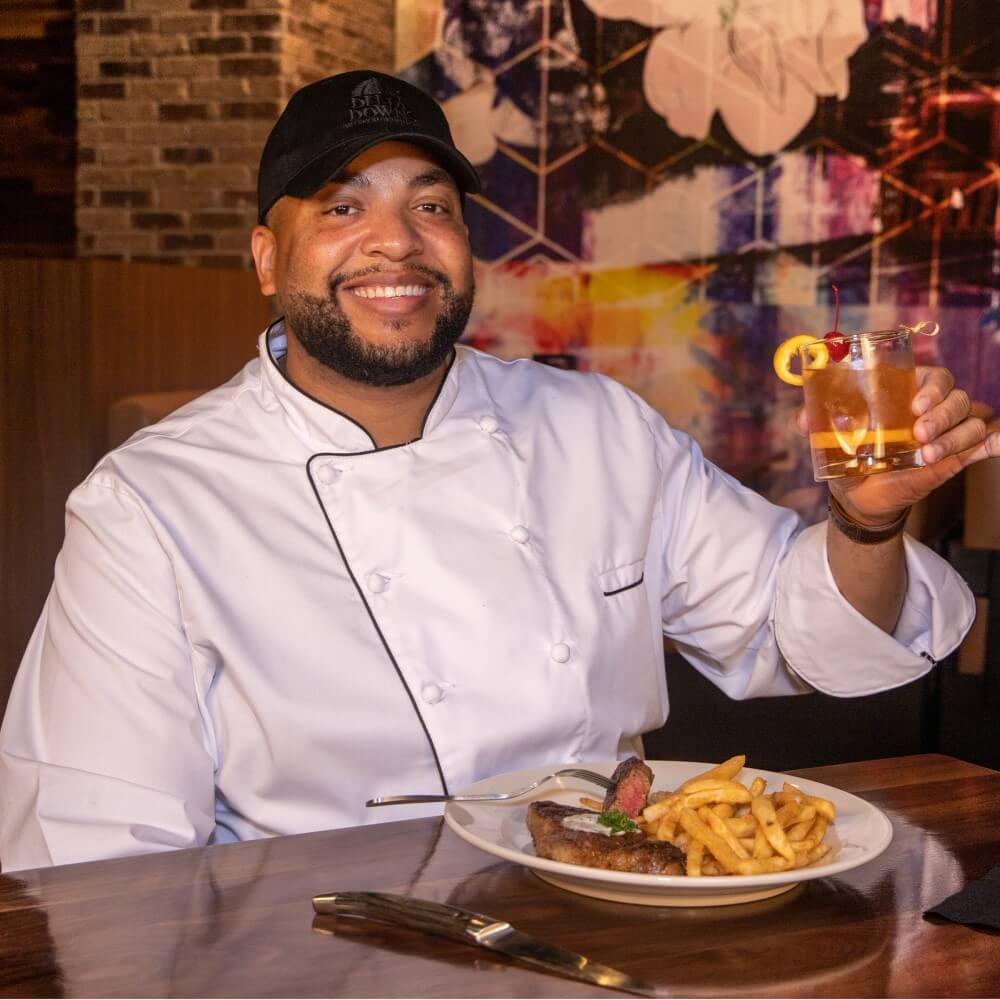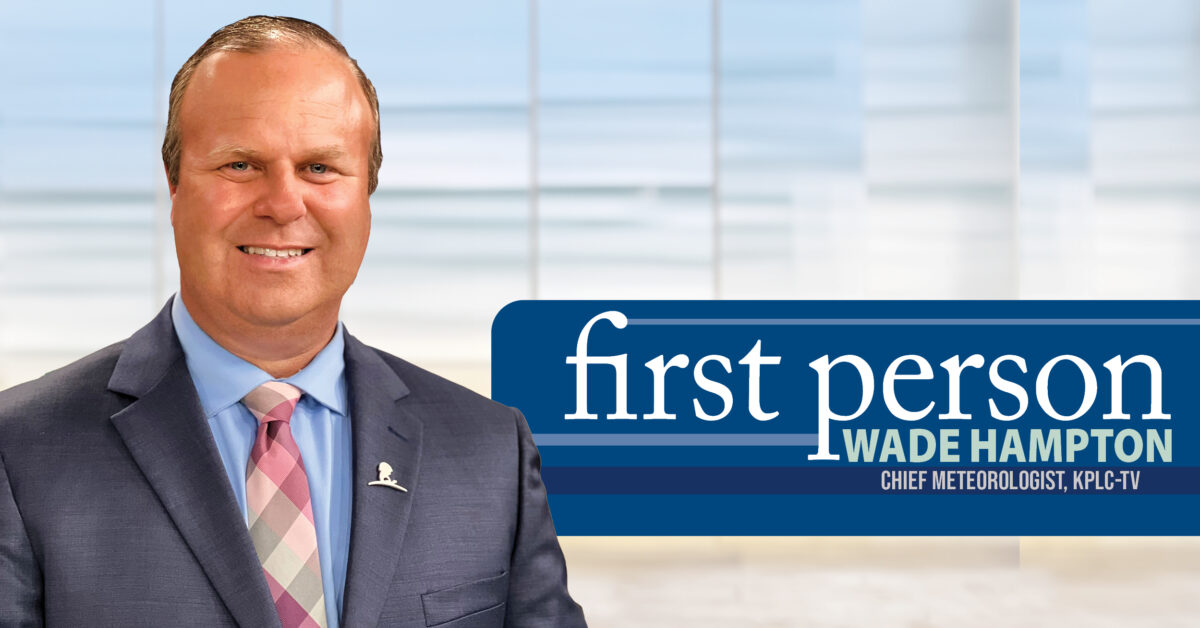
Game Day Fashion
August 2022
It’s a Vibe! Tin Lizard Bar & Grill at Delta Downs Racetrack Casino Hotel
August 2022Oh, Baby!
Let’s be honest – babies are A LOT! A lot of time and effort, a lot of money, a lot of care and patience, and of course, a lot of love. Most parents of grown children will tell you the most rewarding and most challenging role they’ve ever fulfilled is raising their kids. It’s a big job! Whether you are thinking about having a baby, are expecting a baby, or have a baby, the prospect can be overwhelming. In this special section on babies, we hope you’ll find informative articles that might make that big job a little easier.
OB Hospitalists Offer a Higher Level of Care inLabor & Delivery
by Angie Kay Dilmore
Imagine you are in labor and have just arrived at the hospital. Your doctor is called but it might take her some time to arrive. You sense something isn’t right. You’re scared and start to panic. Enter an OB hospitalist.
OB hospitalists are OB/GYN physicians who work in Labor and Delivery units in over a thousand hospitals across the country. They work exclusively in a hospital and are specially trained in labor, delivery, and gynecological emergencies. When there is a concern, an OB hospitalist can attend to the problem quickly, communicate details to your physician, and bridge the gap until your physician arrives. OB hospitalist programs improve the safety of both moms and babies, increase positive outcomes, and give families an extra layer of peace of mind.
CHRISTUS Ochsner Lake Area Hospital is in the process of launching an OB Hospitalist program – the first of its kind in Lake Charles. Dr. Rakhi Dimino, Regional Medical Director of Operations with OB Hospitalist Group, based in Houston, is coordinating the program. She is currently hiring and orienting five to eight physicians who will staff Lake Area Hospital’s program, slated to begin in mid-September. One important program feature is to establish a full coverage OB Emergency Room. “With this program, we have a presence in the hospital 100% of the time. We become safety champions for that labor and delivery unit, watching over the unit and the patients. We can quickly intervene if a situation is headed in the wrong direction, protecting both mom and baby. We not only respond to emergencies, but also try to prevent them from happening, all while coordinating with the patient’s physician.”
“This progressive OB Hospitalist program is strongly supported by our OBGYNs,” states James Brown, MD, CHRISTUS Ochsner Lake Area’s OB Chair. “This program improves quality, safety and the expecting mother’s experience while in labor and sets us apart from all others in SWLA.”
“We want expecting mothers to know when they come to the ER, we have a team ready to work with their obstetrician to provide the best possible care for them,” says David Boudreaux, Administrator, CHRISTUS Ochsner Lake Area Hospital. “When these emergencies happen, it is usually quick. These hospitalists are here to make sure when unexpected care is needed for mom and baby, outcomes are positive.”
In addition to monitoring women in labor and managing emergencies, OB Hospitalists benefit patients in other ways. They can assist a woman who is not pregnant but is having a gynecological emergency. They attend to women who may not have their own private physician. They recognize needs and can take action to improve quality of care, for example, they might work with the blood bank to expedite blood transfusions to women who are hemorrhaging. “We can take a good process and sharpen it, and make it even better,” Dr. Dimino says. “We have the time and the energy to do that on behalf of the hospital.”
“The addition of this OB Hospitalist group is an extension of our commitment to caring for women and their babies,” says Jim Davidson, President and Chief Operating Officer, CHRISTUS Ochsner Health Southwestern Louisiana. “These physicians specialize in obstetrics and emergency care and will work closely with area obstetricians to provide high quality care when time matters. We are glad to have them on our team.”
Safe Sleep Task Force
According to the Centers for Disease Control (CDC), sudden infant death syndrome (SIDS) and unsafe sleeping environments are two of the leading causes of infant deaths. Nationally, Louisiana ranks third highest in this cause of infant death and Southwest Louisiana ranks highest in the state.
The SWLA Safe Sleep Task Force aims to protect the lives of infants through safe sleeping measures. Their goal is to educate parents, professionals, and caregivers on the American Academy of Pediatrics Safe Sleep Guidelines and to improve knowledge, attitudes, and beliefs about the risk of unsafe sleep environments. This group of approximately 30 local community leaders is passionate about their message. They provide educational classes and materials to new and expecting parents and caregivers, as well as continuing education credits for professionals. They partner with various businesses and agencies in the community including physicians, law enforcement, hospitals and, and civic organizations to get the word out through health fairs and other community events.
Executive Committee Task Force member Charlie Hunter is the Chief Investigator and Director of Operations at the Calcasieu Parish Coroner’s Office and was a founding member of the Safe Sleep Task Force. He says his work with the Safe Sleep Task Force is his greatest accomplishment. Hunter has taught hundreds of safe sleep classes and has spoken at hundreds of events spreading their life-saving message. “Over the last 10+ years, our program has successfully reduced infant deaths by 66% thanks to the work of this amazing group.”
Hunter says the Task Force works with law enforcement for their Cops N’ Cribs program. “Each parent who attends a class is provided a free Pack n’ Play portable crib to ensure the infant has a safe place to sleep.” They also work with fire departments for Operation Sleep Sound and with their Acadian Ambulance Service partnership. “Our partnerships with these agencies have allowed our first responders to recognize potentially dangerous situations and intervene with the caregiver as well as provide a safe place for the infant to sleep.”
The Safe Sleep program is self-sufficient as all funds are raised through donations, sponsors, and a yearly Stroll & Roll fundraiser. For more information on Safe Sleep, visit the Task Force website, swlasafesleeptaskforce.webs.com.
Childhood Vaccines: What You Should Know
Since the development of the smallpox vaccine in the late 1700s to today’s COVID-19 vaccines, these medical marvels have been saving lives for over 200 years. Over the decades, numerous potentially deadly diseases such as polio and diphtheria have nearly been eradicated by childhood immunizations.
Dr. Stephanie Treme, pediatrician at the Children’s Clinic, says many children got behind on their vaccinations due to the pandemic and after the 2020 hurricanes. “Now is a great time to catch your child up! Children typically receive vaccines at their checkups between two months and four years old and then again at 11 and 16 years old. With our current vaccine schedule, we can protect kids from over 15 different illnesses that previously killed millions of children around the world annually.”
Dr. Treme highly recommends the COVID-19 vaccine for children. “As a mom of a six-year-old daughter, I was so excited to get her vaccinated on the first day it became available for her age group. It was a huge relief to know that I had done everything in my power to protect her during a potential infection. Getting her vaccinated was never about totally preventing her from catching COVID-19, but instead about protecting her from a bad outcome if she does become infected. Many parents have told me they feel like infection-induced immunity is better or stronger than vaccine-induced immunity, but studies have shown us that is not the case. Patients with the best protection are those who both received the vaccine and also became infected.”
Dr. Treme says there are countless reasons to consider getting a child vaccinated for COVID-19. “They have young, immature immune systems and can easily get overwhelmed by infections. We aren’t sure of all the long-term complications after a covid infection (although we do know there are many possibilities). Trying to prevent your child from feeling really miserably sick is another great reason to get vaccinated. The covid vaccine is one of the most exciting medical advances we’ve seen in our lifetime. It has been shown in large studies to be safe and effective in both adults and children. I frequently hear that the studies on children were too small, but in reality, this vaccine has been one of the most scrutinized medications in history, and the study sizes were pretty large compared to other childhood medications.”
Dr. Treme also says it is important to know about the potential risks with the COVID-19 vaccine. “There are extremely few reasons not to get your child vaccinated. Allergy to vaccine components is the only true contraindication to receiving the COVID-19 vaccine. The ingredients include the mRNA that makes them work, fats, salts, and sugars. They contain no eggs, latex, or preservatives. If you think your child may be allergic to one of the components, talk to your child’s doctor.”
Myocarditis (inflammation in the heart muscles) can be another concern for children who receive the COVID-19 vaccine. “The CDC was very transparent about this risk from early on and started studying it quickly,” Dr. Treme says. “Although there is a very small risk of myocarditis associated with the vaccine (less than 0.01%, and these few cases are typically very mild), there is a much higher risk of developing myocarditis from a COVID-19 infection. In a recent review of patients from more than 900 hospitals in the U.S., children are 37 times more likely to develop myocarditis directly related to a COVID-19 infection than children who have not been infected.”
Dr. Treme says she understands the hesitancy parents experience regarding the COVID-19 vaccine. “It is easy to feel overwhelmed. There is so much information (and misinformation) out there, it can be hard to sift through it all. If you are worried or have specific questions, please talk to your child’s doctor.”
Hearing Impairment Can Have Big Impact for Small Ears
by Tori Hebert
Hearing is a fundamental part of learning. The awe-inducing babbling of infants is actually their way of mimicking sounds they hear. However, nearly two of every 1000 babies are born each year in the United States with hearing impairment.“ Hearing loss is one of the most common childhood obstacles,” said Bridget B. Garrido, Au.D., Doctor of Audiology with Acadiana Hearing & Speech Services. “Without the ability to hear sound, babies cannot pattern speech, which can impact their language skills.”
Universal newborn hearing screening programs are mandatory in Louisiana, where the Early Hearing Detection and Intervention (LEHDI) program oversees screenings on all infants who are born in a hospital or a medical facility. This means a baby’s hearing ability is checked before the family goes home. “The test is quick, painless and can be done while the baby is asleep,” explains Dr. Garrido.
If the baby fails the hospital screening, we see those infants in our office for further diagnostic testing. Without newborn screening, children with hearing impairments often are not diagnosed until two or three years of age.” She says the goal of early screening, combined with follow-up testing and treatment, is to help children with hearing impairment develop language and academic skills on a level equal to that of their peers.
Hearing impairment can be inherited, syndromic or the result of illness or injury before, during or after birth. About 90% of babies with hearing impairments are born to parents with normal hearing, according to the March of Dimes. “Babies with hearing difficulties must be seen by a specialist at one month of age,” says Dr. Garrido. “The goal of the LEHDI program is by one month, retest the infant, at three months, have a complete diagnosis, and by six months of age, have intervention in place.”
Dr. Garrido said parents should be alert to any signs of hearing problems, such as:
- Not turning toward the sound of a voice by six months of age
- Lack of babbling by 12 months of age
- Failure to startle at loud sounds
- Not using single words by 18 months
“If you notice any of these, have your pediatrician refer you to an audiologist,” says Dr. Garrido. “Research shows that if a child’s hearing loss is remedied by six months of age, it will prevent subsequent language delays. Being sure your baby’s hearing is as it should be will help them in every aspect of learning and development.
For more information, or to schedule a hearing evaluation, call Acadiana Speech & Hearing Services at (337) 436-3277 or visit www.acadianhearingservices.com.
Encouraging your Child to Communicate
by Megan Musso, MA, CCC-SLP, IBCLC
Most parents remember their child’s first word, usually around 12 months old, but so much goes into nurturing and encouraging a child’s communication skills before we are rewarded with their precious voice calling out to ‘mama’ and ‘dada’.
Around 18 months of age, you will notice a rapid growth in vocabulary, often labeled a ‘language explosion’. As early as three months your child may begin communicating with you by smiling, cooing and gooing, quieting to your voice, and even crying. As they approach six months, you may be rewarded with a giggle during peek-a-boo or babbling when happy. Talking to your baby during daily routines, reading simple picture books, and responding to their vocalizations are all ways to encourage communication during this stage of infancy. Remember to be playful when interacting with your baby; research shows infants prefer a high-pitched voice with varying tones.
Between six months and a year, things really get fun! Your child is learning to express their self through body language, gestures, and even more diverse vocalizations. Sign language is a great way to help your baby communicate their wants/needs during this time before true words are physically possible. Starting with basic signs during daily routines (eat, drink, all done, book, more) is a wonderful way to help your baby request and participate in the give and take that communication requires. During this time your baby will begin to recognize his/ her name when called, respond to simple commands such as ‘no’ or ‘stop’ and engage in social games such as pat-a-cake and peek-a-boo. Babbling will become more elaborate and include a variety of consonants and vowels, the adorable backwards wave goodbye will emerge as well as clapping, blowing slobbery kisses and unavoidably shaking their head ‘no’. It’s at the end of this most exhausting yet rewarding year of life that you will begin to hear your baby’s babbling form into a true first word, and what a memorable moment that is! Playtime with storybooks, building blocks, and singing in front of a mirror are great ways to encourage communication during this time. Try and choose books with different textures, colors and flaps and toys that encourage stacking, nesting, rolling and exploring.
After you’ve celebrated your baby’s first birthday, you will soon find you have an opinionated toddler with his/her own ideas and what an adventure the next 12 months will be! Your little one will begin imitating you more frequently and progress from speaking one word at a time such as ‘milk’ and ‘car’ to phrases like ‘more milk’ and ‘red car’.
They will begin asking simple questions such as ‘where’s dada?’, following simple directions such as ‘go get your shoes’, identifying objects or pictures in books, and holding mini conversations with you. Reading to your child and describing daily activities, especially using new or unusual words to grab their attention, are all ways to expand communication skills at this age. Whether it be a trip to the grocery store or taking a walk outside, describing and labeling what you see and hear are great ways to build your toddler’s vocabulary. When choosing toys for your child at this age, go back to the basics that don’t require batteries – farm animals and barn, cars, simple puzzles, play kitchen and food, baby dolls; these all encourage pretend play and for your baby to use their voice and imagination. By the time your little one has made his second trip around the sun, you should expect him/her to be speaking mostly in phrases or sentences, have a vocabulary of at least 50 words, and be understood by you and other caregivers about 50% of the time.
The first two years of your baby’s life pass in the blink of an eye. They quickly grow from a tiny infant with their tiny coos and goos into a toddler requesting ‘more animal crackers’ for the 100th time before noon. Enjoy each stage, for it all passes quickly, and remember they are always listening and learning – so read to them, talk to them, ask them questions, give them choices, and celebrate every milestone along the way.
If you feel that your child is not meeting his/her milestones during this early language period, do not hesitate to discuss with your pediatrician, as research shows early intervention at this age is crucial. An evaluation with a licensed speech language pathologist may be recommended to determine if your child has a speech/ language delay and the best course of action to help them improve their communication skills.
For more information on speech and language milestones, visit www.asha.org or call Magnolia Pediatric Therapy, 337-419-0086.
Megan Musso is a licensed speech language pathologist and internationally board certified lactation consultant. She co-authored Tongue-Tied: How A Tiny String Under the Tongue Impacts Nursing, Speech, Feeding and More, and is the owner of Magnolia Pediatric Therapy, where her team of speech pathologists and occupational therapist specialize in speech/language, feeding, lactation, myofunctional and sensory disorders in the pediatric population. Megan lives in Lake Charles with her husband, Charlie, three-year-old Sophie, one-year-old Charles, and newborn Leo.
Life Insurance can Protect your Family’s Future
by Angie Kay Dilmore
Life insurance might not be your top priority when you are busy growing your family, but in fact, this may be the MOST important time to consider buying life insurance – and not only for yourself, but for your children, as well. “Life insurance is key in establishing financial security for those you love,” says State Farm Insurance agent Jennifer Mabou. “Whether it helps pay the mortgage, maintains the current standard of living, pays off debts or pays for college, the life insurance that parents choose can be there when it’s needed most.”
Mabou says it is also beneficial to purchase life insurance for your children. “Starting a life insurance policy for a child gifts them with a lifetime of protection and a valuable asset. A permanent life insurance policy on babies and/or children locks in coverage for life! Even if a medical condition develops later in life, this policy stays in force as long as premiums are paid when due. In many cases, if certain riders are added to the policy, the child may increase their coverage regardless of their health later in life. It guarantees protection for their future loved ones.”
Another benefit is that premiums are generally much lower now than when the same life insurance policy is purchased as an adult. Also, when permanent life insurance is chosen, these premiums stay the same for life, never increasing in cost. “We also offer permanent life insurance policies that can be “paid off” in 10, 15, or 20 years,” adds Mabou. “Those policies often appeal to parents who see the benefit of a lifetime of protection for their children, while not having a premium for a lifetime.”
Mabou says the following questions can help clarify the role life insurance could play in the financial future of your loved ones. “As I always mention to my clients, everyone has a budget. It is my job to find the desired coverage amount that fits each person’s budget. It is absolutely doable!
- Who or what am I trying to protect?
- What are my financial risks and obligations?
- What do I need to protect in the short term?
- What long-range goals or objectives do I need to protect?
- How will changes in my family, career, earning power and plans for retirement affect my needs?
Choosing the right policy doesn’t need to be confusing or overwhelming. Mabou says it’s her responsibility to work with each client, one-on-one, to help ensure they have the right amount and type of life insurance in place. She adds, “Life insurance is more than just covering “funeral expenses”. It is about how life goes on after we lose a loved one. It does not replace our loved ones, but it does reduce financial burdens. I feel honored that my clients trust me to help them protect the financial future of their families.”
For more information, call or visit Jennifer Mabou at 1633 Beglis Pkwy, Sulphur, LA, 337-527-0027.
Oh, Snap! Modern Baby Clothes Pair Minimalistic Comfort & Convenience for a Perfect Match
by Victoria Ellender
No more fussing with zippers, buttons and rows of snaps in the middle of the night. Parents today have fallen head over heels with a new clothing trend that makes dressing babies intuitive and quick. Magnetic snaps have revolutionized newborn apparel, simplifying the process of dressing newborns and giving outfits a natural comfort.
According to Jenna Young, owner of Pink and Blue Avenue in Lake Charles, today’s parents are concerned with comfort and convenience first when it comes to dressing their newborns. From cool bamboo to soft organic cottons, new arrivals are swaddled in cozy from day one. “When it comes to dressing today’s baby and toddler, parents are opting for simple and soft,” she said. “Organic materials with convenient fasteners are by far our most popular choice.”
Convenient Simplicity
Pink and Blue Avenue carries several brands that simplify the dressing process for parents including Magnetic Me, one of the most popular makers of magnetic baby apparel. Magnetic Me offers a variety of options with magnetic closures including body suits, footies, swaddler sets, newborn gowns and rompers. While soft materials and easy-to-wear options are the most sought-after for every day wear, traditional smocked gowns and suits are still an important staple for many parents today. “Classic baby layette options remain on trend, including brands like Feltman Brothers and Petite Ami,” said Young. “Those beautiful smocked outfits and infant gowns are still being worn today.”
Eco-Friendly & Organic Options
With comfort in mind, today’s babies are being wrapped in the softest, most breathable materials, sustainably made from beechwood trees, bamboo and organic cotton. “Some of our most popular brands for babies and toddlers include Posh Peanut, Kyte Baby and Magnetic Me. These lines offer fashionable styles with those wonderfully soft organic and hypoallergenic materials that today’s parents are looking for.”
Minimalistic Color Palettes & Earthy Tones
Young said earthy solid colors and subtle prints pair well to bring soft, comfortable outfits together for infants and toddlers. “Quincy Mae is a beautiful, trending organic option that parents today love for their little ones.”
Looking for that perfect baby gift or want to dress your baby in stylish comfort? Pink and Blue Avenue is located at 4070 Nelson Road, #900 in Lake Charles. Find them on Facebook or their website, pinkandblueavenue.com.






